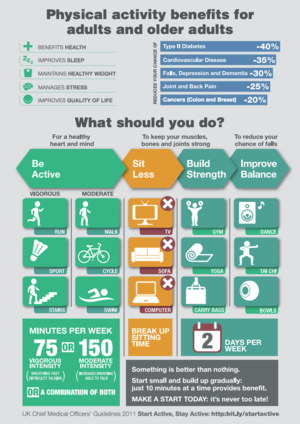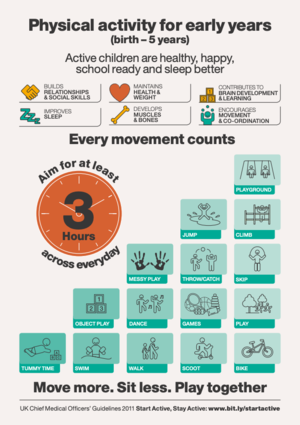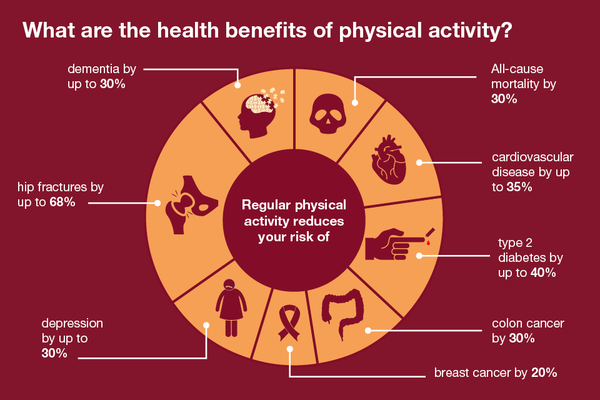Benefits of Physical Activity
Top Contributors - Wendy Walker, Admin, Chelsea Mclene, Tarina van der Stockt, Simisola Ajeyalemi, George Prudden, Michelle Lee, Kim Jackson, Shaimaa Eldib, Claire Knott, Rucha Gadgil, Jess Bell, Olajumoke Ogunleye and Tony Lowe
Evidence of Benefits of Physical Activity[edit | edit source]
Physical activity [PA] has become a public health priority[11] because of the overwhelming body of evidence supporting its effectiveness as a holistic health intervention[1].
As long ago as the 1950s, Professor Morris and his colleagues demonstrated that men engaged in work requiring a level of physical activity (e.g. postmen or bus conductors) were less likely to suffer from coronary heart disease than men with sedentary jobs (e.g. bus drivers or clerical workers)[2]. Since this time, many studies in different countries and populations have demonstrated the benefits of PA in a wide variety of health conditions, in some cases showing an effect equal to or even greater than medication[3].
There appears to be a linear relation between physical activity and health status, such that a further increase in physical activity and fitness will lead to additional improvements in health status[1].
Historical Perspective[edit | edit source]
Human beings are built for movement. For much of history, we were hunters and gatherers and our genes have evolved to accommodate the high energy expenditure levels required to be successful and thrive in the environment[4][5].
Yet in the 21st century, in many countries of the world people spend large periods of the day sitting down, whether at desks, computers or in transport; one study[6] states "With the evolution of the development of knowledge and progress in automatic technologies, the human society gradually turned into a sedentary population. It is moreover clearly established that physical activity is insufficient in Europe and in the developed countries. The physical activity is certainly beneficial for many reasons, but it is especially the inactivity which is dangerous." [6].
Health-Related Components of Physical Fitness[7][edit | edit source]
- Cardiorespiratory endurance: the ability of the circulatory and respiratory system to supply oxygen during PA.
- Muscular strength: the ability of the muscle to exert force.
- Muscular endurance: the ability of the muscle to perform without fatigue.
- Flexibility: the range of motion present in a joint.
- Body composition: the relative amounts of muscle, bone, fat and other body tissues[8].
[edit | edit source]
- Improve glucose homeostasis and insulin sensitivity[8][9]
- Reduce blood pressure[10][11]
- Improve autonomic tone[12]
- Decrease blood coagulation[13]
- Improve coronary blood flow[14]
- Enhance lipid lipoprotein profiles (e.g., through reduced triglyceride levels, increased high-density lipoprotein [HDL] cholesterol levels and decreased low-density lipoprotein [LDL]-to-HDL ratios)[8][15][16][17]
- Reduce systemic inflammation[18]
- Augment cardiac function[19][20]
- Enhance endothelial function[21][22][23]
Skill Related Physical Fitness Components[edit | edit source]
- Coordination: the ability to use the senses together with body parts to perform motor tasks accurately[24]
- Balance: the maintenance of equilibrium whilst moving or stationary[25]
- Agility: the ability to change the position of the body in space with speed & accuracy
- Speed: the ability to perform a movement swiftly/within a short period of time
- Reaction time: the time between stimulation and the start of a response/reaction to it[25]
Mental Health Related Physical Fitness Components[edit | edit source]
Routine physical activity is associated with improved psychological well-being[26][1][8] (e.g., through reduced stress, anxiety and depression). See the PA and Mental Health page for more details.
Related Physiopedia Pages[edit | edit source]
Conditions[edit | edit source]
The following pages provide more information, evidence and references on the benefits of PA in specific groups of conditions:
- Physical Activity and NCDs
- Physical Activity in Long Term Musculoskeletal Conditions
- Physical Activity and Neurological Conditions
- Physical Activity and Respiratory Conditions
- Physical Activity and Cardiovascular Disease
- Physical Activity in Diabetes
- Physical Activity in Cancer
- Stroke: The Role of Physical Activity
Populations[edit | edit source]
These pages provide more information, evidence and references on the benefits of PA in specific population groups:
- Physical Activity in Young People
- Physical Activity in Older Adults
- Physical Activity and Women
- Physical Activity and Men
- Physical Activity in Individuals with a Disability
References[edit | edit source]
- ↑ 1.0 1.1 1.2 Warburton DER, Nicol CW, Bredlin SSD. Health benefits of physical activity: the evidence. Can Med Assoc J 2006;174(6):801-09
- ↑ Paffenbarger RS Jr, Blair SN, Lee IM. A history of physical activity, cardiovascular health and longevity: the scientific contributions of Jeremy N Morris, DSc, DPH, FRCP. Int J Epidemiol 2001;30(5):1184-92
- ↑ Naci H, Ioannidis JPA. Comparative effectiveness of exercise and drug interventions on mortality outcomes: metaepidemiological study. BMJ 2013;347:f5577
- ↑ Katzmarzyk PT. Physical activity, sedentary behavior, and health: paradigm paralysis or paradigm shift? Diabetes 2010;59:2717-2725
- ↑ Booth FW, Chakravarthy MV, Gordon SE, Spangenburg EE. Waging war on physical inactivity: using modern molecular ammunition against an ancient enemy. J Appl Physiol 2002;93:3-30
- ↑ 6.0 6.1 Grosclaude M, Ziltener JL. Benefits of physical activity. Rev Med Suisse [01 Aug 2010, 6(258):1495-1498]
- ↑ Darren E.R. Warburton, Crystal Whitney Nicol, and Shannon S.D. Bredin Health benefits of physical activity: the evidence. CMAJ. 2006 Mar 14; 174(6): 801–809
- ↑ 8.0 8.1 8.2 8.3 Warburton DE1, Gledhill N, Quinney A. Musculoskeletal fitness and health. Can J Appl Physiol. 2001 Apr;26(2):217-37.
- ↑ Wallberg-Henriksson H, Rincon J, Zierath JR. Exercise in the management of non-insulin-dependent diabetes mellitus. Sports Med 1998;25:25-35
- ↑ Blair SN, Goodyear NN, Gibbons LW, et al. Physical fitness and incidence of hypertension in healthy normotensive men and women. JAMA 1984;252:487-90
- ↑ Paffenbarger RS Jr, Jung DL, Leung RW, et al. Physical activity and hypertension: an epidemiological view. Ann Med 1991;23:319-27
- ↑ Adamopoulos S, Piepoli M, McCance A, et al. Comparison of different methods for assessing sympathovagal balance in chronic congestive heart failure secondary to coronary artery disease. Am J Cardiol 1992;70:1576-82
- ↑ Rauramaa R, Salonen JT, Seppanen K, et al. Inhibition of platelet aggregability by moderate-intensity physical exercise: a randomized clinical trial in overweight men. Circulation1986;74:939-44
- ↑ Hambrecht R, Wolf A, Gielen S, et al. Effect of exercise on coronary endothelial function in patients with coronary artery disease. N Engl J Med 2000;342:454-60
- ↑ Berg A, Halle M, Franz I, et al. Physical activity and lipoprotein metabolism: epidemiological evidence and clinical trials. Eur J Med Res 1997;2:259-64
- ↑ Halle M, Berg A, von Stein T, et al. Lipoprotein(a) in endurance athletes, power athletes, and sedentary controls. Med Sci Sports Exerc 1996;28:962-6
- ↑ DuRant RH, Baranowski T, Rhodes T, et al. Association among serum lipid and lipoprotein concentrations and physical activity, physical fitness, and body composition in young children. J Pediatr 1993;123:185-92
- ↑ Adamopoulos S, Parissis J, Kroupis C, et al. Physical training reduces peripheral markers of inflammation in patients with chronic heart failure. Eur Heart J 2001;22:791-7
- ↑ Warburton DER, Gledhill N, Jamnik V, et al. Induced hypervolemia, cardiac function, VO2max and performance of elite cyclists. Med Sci Sports Exerc 1999;31:800-8
- ↑ Warburton DE, Haykowsky MJ, Quinney HA, et al. Blood volume expansion and cardiorespiratory function: effects of training modality. Med Sci Sports Exerc 2004;36:991-1000
- ↑ Gokce N, Vita JA, Bader DS, et al. Effect of exercise on upper and lower extremity endothelial function in patients with coronary artery disease. Am J Cardiol 2002;90: 124-7
- ↑ Kobayashi N, Tsuruya Y, Iwasawa T, et al. Exercise training in patients with chronic heart failure improves endothelial function predominantly in the trained extremities. Circ J2003;67:505-10
- ↑ Hambrecht R, Gielen S, Linke A, et al. Effects of exercise training on left ventricular function and peripheral resistance in patients with chronic heart failure: a randomized trial. JAMA 2000;283:3095-101
- ↑ <header> </header><section> Wu, Yen-Hsun; Latash, Mark L. The Effects of Practice on Coordination </section><section> Exercise and Sport Sciences Reviews: January 2014 - Volume 42 - Issue 1 - p 37–42 </section>
- ↑ 25.0 25.1 Stephen Lord, Sally Castell Effect of exercise on balance, strength and reaction time in older people. Australian Journal of Physiotherapy, Volume 40, Issue 2, 1994, Pages 83-88
- ↑ Dunn AL, Trivedi MH, O'Neal HA. Physical activity dose–response effects on outcomes of depression and anxiety. [discussion 609-10]. Med Sci Sports Exerc 2001;33:S587-97









